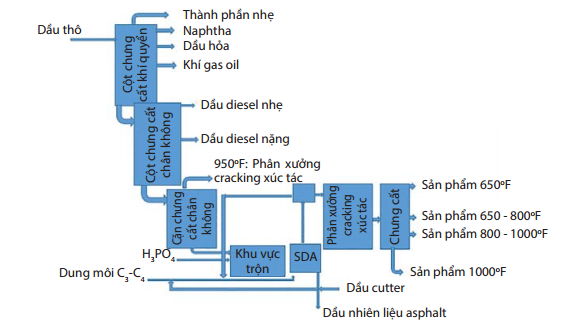Study of the possible removal of metals (Fe, Ni, V, Ca and Na) contaminating FCC catalyst in crude oil desalting process
Abstract
Crude oil contains trace amounts of vanadium, iron, calcium and nickel (V, Fe, Ca and Ni), usually in oil-soluble form. These metals agglomerate in the residual fuel oil fractions, which are feedstock for the RFCC unit. During the cracking process, the metals accumulate on the FCC catalyst, decreasing the catalytic activity and changing the physicochemical properties of fuels. This paper illustrates the performance of the removal of Fe, Ni, Ca and V from crude oil by extraction method with organic diacid system and hydroxyl acid. The results obtained from atomic absorption spectroscopy (AAS) show that the mixture of lactic acid, oxalic acid and citric acid has good performance in removing contaminated metals, with 3.91ppm of Fe, 6.42ppm of Ni, 23.85ppm of Ca and 25.87ppm of Na being removed. In addition, the results from the inductively coupled plasma method (ICP) reveal that the removal of Ni, V, Fe, Ca and Na were 46%, 51%, 66%, 85% and 78% respectively.
References
2. Mohammad Farhat Ali, Saeed Abbas. Areviewofmethodsfor the demetallization of residual fuel oils. Fuel Processing Technology. 2006; 87(7): p. 573 - 584.
3. P.K.Eidem. Reducing the metals content of petroleum feedstocks. U.S Patent No. 4752382. Assignee: Chevron Research Company, San Francisco, California. Jun 21, 1988.
4. S.G.Kukes, A.W.Aldag. Chemical demetalation of heavy oils. Preprints - American Chemical Society, Division of Petroleum Chemistry. 1985; 30 (1): p. 119 - 129.
5. K.Welter, E.Salazar, Y.Balladores, O.P.Márquez,J.Márquez, Y.Martínez. Electrochemical removal of metals from crude oil samples. Fuel Processing Technology. 2009; 90(2): p. 212 - 221.
6. Hui Shang, Yu Liu, Jin-Chun Shi, Quan Shi, Wen-Hui Zhang. Microwave- assisted nickel and vanadium removal from crude oil. Fuel Processing Technology. 2016; 142: p. 250 - 257.
7. Chevron Research Co. Demetalation of heavy hydrocarbon oils. Jpn. Kokai Tokyo Koho JP 63 61,087, US Appl, 901344, 28. Assigned to Chevron Research Co., US. 1986.
8. D.L.Rollmann, D.E.Walsh. Visbreaking process for demetalation and desulfurization of heavy oil. US Patent 4203830. Mobil Oil Croporation. 1980.
9. Garima Chauhuan, K.K.Pant, K.D.P.Nigam. Conceptual mechanism and kinetic studies of chelateing agent assisted metal extraction process from spent catalyst. Journal of Industrial and Engineering Chemistry. 2015; 27: p. 373 - 383.
10. Se In Cho, Kwang Seop Jung, Seong Ihl Woo. Regeneration of spent RFCC catalyst irreversibly deactivated by Ni, Fe, and V contained in heavy oil. Applied Catalysis B: Environmental. 2001; 33(3): p. 249 - 261.
11. Xin Pu, Jin-ning Luan, Li Shi. Reuse of spent FCC catalyst for removing trace olefins from aromatics. Bulletin of the Korean Chemical Society. 2012; 33(8): p. 2642 - 2646.
12. Bhargavi Surbramanian, Vasuadenvan Namboodiri, Amid P.Khodadoust, Dionysios D.Dionysious. Extraction of pentachlorophenol from soils using environmentally benign lactic acid solutions. Journal of Hazardous Materials. 2010; 174(1 - 3): p. 263 - 269.

1. The Author assigns all copyright in and to the article (the Work) to the Petrovietnam Journal, including the right to publish, republish, transmit, sell and distribute the Work in whole or in part in electronic and print editions of the Journal, in all media of expression now known or later developed.
2. By this assignment of copyright to the Petrovietnam Journal, reproduction, posting, transmission, distribution or other use of the Work in whole or in part in any medium by the Author requires a full citation to the Journal, suitable in form and content as follows: title of article, authors’ names, journal title, volume, issue, year, copyright owner as specified in the Journal, DOI number. Links to the final article published on the website of the Journal are encouraged.




